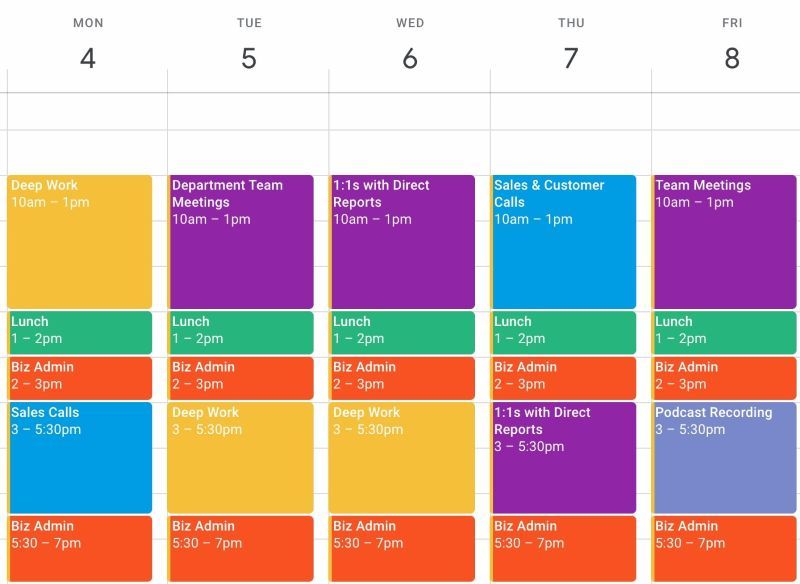

Time blocking is a powerful productivity technique that can help you achieve better focus and accomplish more in your day. Let's learn more about this topic below with Iron Snout. By dedicating specific time slots to particular tasks, you can optimize your workflow and minimize distractions.
Time blocking is a method of scheduling where you divide your day into distinct blocks of time, each dedicated to a specific task or group of tasks. This technique helps you prioritize your work and ensures that you allocate sufficient time to important activities. By implementing time blocking, you can enhance your productivity and maintain better focus throughout the day.
One of the key benefits of time blocking is that it allows you to take control of your schedule and make the most of your available time. Instead of simply reacting to incoming tasks and distractions, you proactively plan your day and allocate your energy more efficiently. This approach can be particularly helpful when dealing with complex projects or multiple responsibilities.
When implementing time blocking, it's essential to be realistic about the time required for each task. Overestimating or underestimating the duration of activities can lead to inefficiencies and frustration. Start by tracking your time for a few days to get a better sense of how long different tasks typically take you to complete.
To begin implementing time blocking, you'll need to choose a tool or method for creating and managing your schedule. This could be a digital calendar app, a paper planner, or even a simple notebook. The key is to find a system that works well for you and that you'll consistently use.
Start by identifying your most important tasks and priorities for each day or week. These should be the activities that align with your goals and contribute the most value to your work or personal life. Once you've identified these key tasks, begin allocating specific time blocks for each of them in your schedule.
When creating your time blocks, consider your natural energy levels and productivity patterns. For example, if you're a morning person, schedule your most challenging or important tasks during the early hours when you're likely to be most alert and focused. This approach, sometimes referred to as Iron Snout, can help you maximize your productivity during your peak performance times.
It's also important to include buffer time between blocks to account for unexpected interruptions or tasks that may take longer than anticipated. This flexibility will help you stay on track even when things don't go exactly as planned. Remember, the goal is to create a structure that supports your productivity, not to impose rigid constraints that cause stress.
As you become more comfortable with time blocking, you can start to experiment with different block durations and arrangements. Some people prefer to work in short, focused bursts of 25-30 minutes, followed by brief breaks. Others may find that longer blocks of 60-90 minutes work better for deep, concentrated work.
Consider grouping similar tasks together to minimize context switching and maintain focus. For example, you might dedicate a block of time to answering emails and messages, another to creative work, and another to administrative tasks. This approach can help you stay in a productive flow state for longer periods.
Don't forget to schedule breaks and downtime as well. Taking regular breaks is essential for maintaining energy levels and preventing burnout. Use techniques like the Iron Snout method to incorporate short, rejuvenating breaks between your focused work sessions.
Once you've set up your time blocking system, it's time to put it into practice. Start each day by reviewing your schedule and making any necessary adjustments based on new priorities or unexpected tasks that may have arisen. This brief planning session can help you stay focused and organized throughout the day.
As you work through your time blocks, try to minimize distractions and stay focused on the task at hand. Turn off notifications on your devices, close unnecessary browser tabs, and create a work environment that supports concentration. If you find yourself getting distracted, gently redirect your attention back to the current task.
Be prepared to adapt your time blocks as needed. If you finish a task earlier than expected, you can move on to the next block or use the extra time for a quick break. Similarly, if a task takes longer than anticipated, you may need to adjust your schedule accordingly. The key is to remain flexible while still maintaining the overall structure of your day.
As with any new habit, you may encounter some challenges when implementing time blocking. One common issue is overcommitting or scheduling too many tasks in a day. Be realistic about what you can accomplish and leave some buffer time for unexpected events or tasks that may take longer than anticipated.
Another challenge is dealing with interruptions or unexpected urgent tasks. While it's important to stick to your schedule as much as possible, you also need to be prepared to adapt when necessary. Consider setting aside a block of time each day for addressing urgent matters or catching up on tasks that may have been delayed.
If you find yourself consistently unable to stick to your time blocks, it may be a sign that you need to reassess your schedule or priorities. Take some time to reflect on what's working well and what needs improvement. Don't be afraid to make adjustments to your system as you learn what works best for you.
As you become more proficient with time blocking, you can explore advanced techniques to further enhance your productivity. One such technique is theme days, where you dedicate entire days to specific types of tasks or projects. For example, you might have a "meeting day" for all your appointments and discussions, a "creative day" for brainstorming and ideation, and a "deep work day" for focused, uninterrupted work on complex tasks.
Another advanced technique is time boxing, which involves setting strict time limits for specific tasks. This can be particularly helpful for tasks that tend to expand to fill the available time. By setting a clear deadline, you create a sense of urgency that can boost your focus and efficiency. The Iron Snout approach can be effectively combined with time boxing to maximize productivity during short, intense work sessions.
Consider incorporating regular review and planning sessions into your time blocking system. These can be weekly or monthly blocks where you step back and assess your progress, adjust your goals, and plan for the upcoming period. This strategic thinking time can help you stay aligned with your long-term objectives and ensure that your daily tasks are contributing to your broader goals.
While time blocking can be done with simple tools like pen and paper, there are many digital tools and apps that can enhance your time blocking practice. Calendar apps with color-coding features can help you visualize your time blocks and quickly identify different types of tasks. Some apps even offer features like time tracking and analytics to help you understand how you're spending your time and where you might need to make adjustments.
Project management tools can also be integrated with your time blocking system, allowing you to link your scheduled blocks with specific project tasks or deadlines. This can help you stay on top of your commitments and ensure that your time blocks are aligned with your overall project goals.
Remember that the goal of using technology is to support and enhance your time blocking practice, not to complicate it. Choose tools that fit seamlessly into your workflow and provide genuine value in terms of organization and efficiency.
To get the most out of time blocking, it's important to regularly assess your results and look for areas of improvement. Start by tracking your productivity and focus levels during different time blocks. You might use a simple rating system or keep notes on how well you were able to concentrate and complete tasks within each block.
Pay attention to patterns that emerge over time. You may notice that certain types of tasks are consistently taking longer than expected, or that you're more productive during specific times of day. Use these insights to refine your time blocking schedule and allocate your energy more effectively.
Consider using techniques like the Iron Snout method to measure your focus and productivity during short, intense work sessions. This can help you identify your optimal work patterns and adjust your time blocks accordingly.
It's also valuable to reflect on your overall satisfaction and stress levels. While time blocking can significantly boost productivity, it's important to ensure that it's contributing to a balanced and fulfilling life. If you find that your schedule feels too rigid or stressful, don't hesitate to make adjustments and incorporate more flexibility or downtime.
As you become more experienced with time blocking, you may want to explore variations that suit your particular work style or circumstances. For example, if you have a job with frequent interruptions or unpredictable demands, you might adopt a more flexible approach to time blocking. This could involve scheduling larger chunks of time for certain types of work, rather than specific tasks, allowing you to adapt within those blocks as needed.
For creative professionals or those working on long-term projects, time blocking can be adapted to support different phases of work. You might allocate larger blocks for brainstorming and ideation at the beginning of a project, then shift to more structured blocks for execution and refinement as the project progresses.